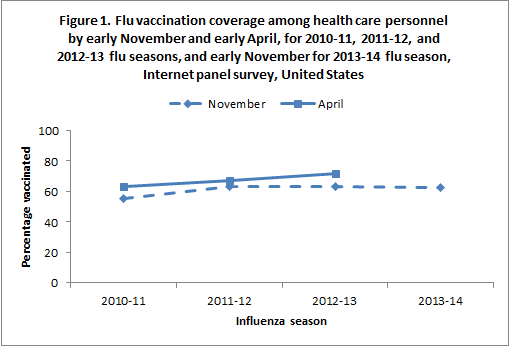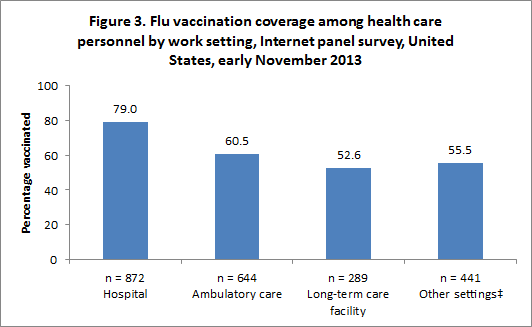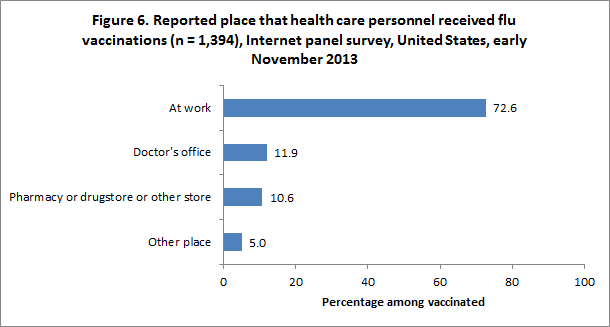Health Care Personnel and Flu Vaccination, Internet Panel Survey, United States, November 2013
Influenza (flu) among health care personnel (HCP) can result in medical visits and lost work days for the HCP and can spread flu to their patients (1). Patients with chronic medical conditions, pregnant women, young children, and older people are at higher risk of serious flu complications.
- Flu vaccination has been shown to reduce the risk of flu and absenteeism in vaccinated HCP and reduce the risk of respiratory illness and deaths in nursing home residents (2–5).
- The Advisory Committee on Immunization Practices (ACIP) recommends that all HCP receive an annual flu vaccination (1).
- Flu vaccination coverage among HCP has improved but remains below the national Healthy People 2020 target of 90% (6).
- In the 2007-08 flu season, HCP vaccination coverage was 48% based on data from the National Health Interview Survey (NHIS), the data source used to monitor the Healthy People 2020 objective (7).
- By the 2011-12 flu season, vaccination coverage increased to 62% (7).
- Vaccination coverage measured with the Internet panel survey* was 67% during the 2011-12 season and 72% during the 2012-13 season (7, 8).
CDC analyzed data from an Internet panel survey conducted from October 30-November 15, 2013, among HCP. The results of this survey provide information for use in vaccination campaigns during National Influenza Vaccination Week (December 8-14, 2013). This report provides early flu season (early November) estimates of vaccination coverage among HCP. Final 2013-14 flu season HCP vaccination coverage estimates will be available after the end of the season.
Key Findings
- Early season 2013-14 flu vaccination coverage among HCP was 62.9%, similar to coverage by early season 2012-13 (63.4%).
- During the previous two seasons, flu vaccination coverage increased by 3-9% from early season to the end of the season.
- By occupation, flu vaccination was highest among pharmacists (89.9%), physicians (84.3%), nurses (79.3%), nurse practitioners/physician assistants (77.8%), and other clinical professionals (71.1%).
- Flu vaccination was lowest among assistants/aides (49.2%) and administrative/non-clinical support staff (54.0%).
- By work setting, flu vaccination coverage was highest among HCP working in hospitals (79.0%).
- Flu vaccination was lowest among HCP working in long-term care facilities (52.6%).
- Flu vaccination coverage was higher among HCP whose employers required (88.8%) or recommended (70.1%) that they be vaccinated compared to those HCP who did not have an employer policy regarding flu vaccination (44.3%).
- Among unvaccinated HCP who did not intend to get the flu vaccination, the most common reason reported for not getting vaccinated was that they did not want vaccination. The second most common reason was that they might get sick from the vaccine.
Conclusion/Recommendations:
- While overall HCP flu vaccination has improved in the last several years, vaccination continues to lag among assistants, aides, non-clinical support staff, and HCP working in long-term care.
- Targeted efforts are needed to improve coverage among these HCP groups, including ensuring convenient access to flu vaccine at the workplace at no cost to the HCP.
Who Was Vaccinated?
Coverage by Occupation
- Flu vaccination coverage was higher among pharmacists (89.9%), physicians (84.3%), nurses (79.3%), nurse practitioners and physician assistants (77.8%), and other clinical personnel (71.1%) compared to assistants/aides (49.2%) and administrative/non-clinical support staff (54.0%).
- Flu vaccination coverage decreased from early season 2012-13 to early season 2013-14 by 7.2 percentage points among nurse practitioners and physician assistants. Coverage for other occupational groups was similar in early season 2012-13 and early season 2013-14.
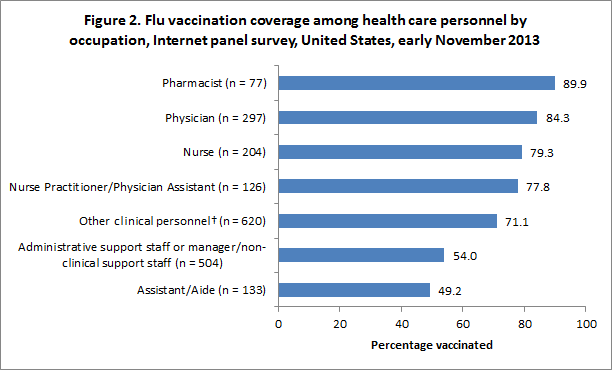
Coverage by Age Group
- Flu vaccination coverage among HCP varied by age, ranging from 62.3% in HCP 18-49 years to 67.8% in HCP 65 years and older.
- Coverage in early season 2013-14 decreased by 7 percentage points among HCP 50-64 years compared to early season 2012-13. Coverage for all other age groups was similar in early season 2012-13 and early season 2013-14.
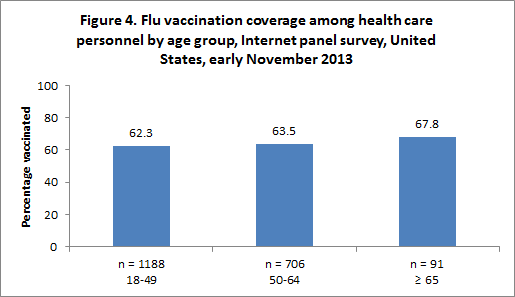
Coverage by Employer Requirement or Recommendation
- Flu vaccination coverage was highest among HCP with an employer requirement for vaccination (88.8%). Vaccination coverage was higher among HCP with an employer recommendation but no requirement (70.1%) compared to those whose employers had neither a requirement nor recommendation for vaccination (44.3%).
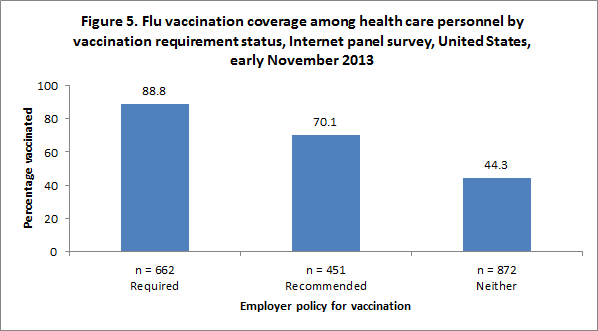
- HCP working in hospitals were more likely to report an employer requirement for vaccination than HCP working in ambulatory care, long-term care facilities, and other settings (Table 1).
| Percentage of HCP with an employer requirement for vaccination | Percentage vaccinated among HCP with and without an employer requirement for vaccination | |||
|---|---|---|---|---|
| Required | Not required | |||
| Unweighted n | Weighted % | Weighted % | Weighted % | |
| Hospital | 484 | 52.1 | 90.3 | 66.8 |
| Ambulatory care / Physician office | 187 | 25.0 | 79.6 | 54.2 |
| Long-term care facility | 45 | 10.1 | 94.6 | 47.9 |
| Other setting† | 78 | 15.6 | 90.7 | 49.0 |
| Total | 662 | 28.5 | 88.8 | 52.6 |
Main Reason for Receiving Vaccination
- Protecting themselves from flu was the most common main reason reported by vaccinated HCP for receiving the flu vaccination.
- Employer requirement for flu vaccination and protecting friends, family, and patients from flu were also commonly reported main reasons why vaccinated HCP decided to get the flu vaccination.
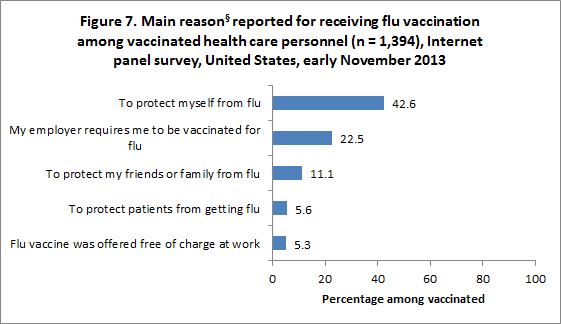
Main Reason for Not Receiving Vaccination
- Among unvaccinated HCP who reported that they did not intend to get flu vaccination this year**, the most commonly reported main reason was that they did not want vaccination.
- Other reasons commonly reported for not receiving flu vaccination included fear of getting sick or side effects from vaccination, thinking that flu vaccinations do not work, being allergic to the vaccine, and thinking that flu vaccination was not needed.
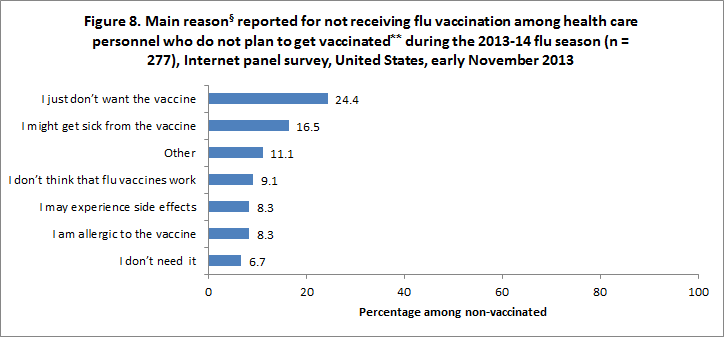
What Can Be Done? (Recommendations)
Overall, the early season estimate of flu vaccination coverage among HCP in 2013-14 (62.9%) was similar to early season coverage in 2012-13 (63.4%). Flu vaccination coverage among HCP working in hospital settings, and pharmacists, physicians, nurse practitioners, physician assistants, nurses, and other clinical personnel across all work settings was substantially higher than coverage among other categories of HCP and among HCP working in long-term care facilities and other work settings. The success of vaccine promotion in raising coverage among these clinical care groups should serve as an example for HCP in other work settings.
Additional efforts are needed to improve vaccination coverage among HCP in work settings other than hospitals, especially in long-term care facilities, and among assistants/aides and administrative/non-clinical support staff in all work settings. Continued efforts are needed to ensure all HCP are vaccinated as soon as possible during every flu season, including: Implementing interventions to promote flu vaccination among HCP each season:
- Employers should reduce barriers to HCP vaccination by considering offering flu vaccination:
- Onsite over multiple days and shifts
- Free of charge
- With active promotion
- Employers and health care administrators should make use of the Community Guide for Preventive Services, which provides guidance on effective interventions to increase the use of flu vaccination (9).
The November Internet panel survey of HCP is designed to provide estimates of national flu vaccination coverage among HCP and to assess the effectiveness of current vaccination efforts. The follow-up survey in April 2014 will provide end-of-season flu vaccination coverage estimates.
Data Source and Methods
CDC collected data from two pre-existing web-based panels from October 30-November 15, 2013. Clinical personnel were recruited from the membership of Medscape, a web portal managed by WebMD Professional Services, and non-clinical personnel were recruited from SurveySpot, a general population Internet panel. The sample was weighted to reflect the demographic composition of the target population of U.S. HCP. Survey items included vaccination during the current flu season, vaccination history, and knowledge, attitudes, and beliefs concerning flu and flu vaccination. There were 2,062 HCP who were eligible for and entered the survey and 1,986 (96.3%) who completed the survey. Weighted estimates were calculated based on each occupational group by age, gender, race/ethnicity, health care work setting, and census region to be generalizable to the U.S. population of HCP.
Weighted analyses were conducted using SAS v9.2 survey procedures. Because the opt-in Internet panel sample is based on those who self-selected for participation in the panels rather than a random probability sample, statistical measures such as calculation of confidence intervals and tests of differences cannot be performed (10). A difference of 5 percentage points was considered a notable difference.
Sample Demographics
- A total of 1,985†† HCP were included in the survey.
- By age, 1,188 (66.0%) were 18-49 years, 706 (29.0%) were 50-64 years, and 91 (5.0%) were 65 years and older.
- For additional occupation characteristics, please see the attached table hcp-occupation-2013.xlsx [XLSX-10K] .
- For additional work setting characteristics, please see the attached table hcp-worksetting-2013.xlsx [XLSX-9K] .
Limitations
These results are preliminary and should be interpreted with caution. The follow-up survey in April 2014 will assess flu vaccination coverage for the entire flu season. Final estimates for the 2013-14 flu season will be adjusted to account for differences in respondent characteristics that may be associated with flu vaccination coverage and may affect estimated levels of flu vaccination among different subgroups of HCP.
The findings in the report are subject to several limitations.
- The sample was not necessarily representative of the approximately 18 million HCP in the United States. The survey was conducted among a much smaller group of volunteer HCP (a non-probability sample) who had already enrolled in Medscape or SurveySpot rather than a randomly selected sample.
- Some bias may remain in estimates after weighting the sample to improve representativeness, given the exclusion of individuals with no Internet access and the self-selection processes for entry into the panels and participation in the survey. Estimates might be biased if the selection processes for entry into the Internet panels and the decision to participate in this particular survey were related to receipt of vaccination.
- All vaccination results are based on self-report and are not verified by employment or medical records.
- The definition of HCP used in this Internet panel survey (persons who worked in a medical care setting or whose work involved hands-on care of patients) might vary from definitions used in other surveys of vaccination coverage.
- Occupational categories could not always be separated because of small sample sizes, questionnaire design, or other limitations.
- The 2013-14 estimates might not be directly comparable to estimates from population-based surveys. Compared with estimates from NHIS, flu vaccination among HCP from the Internet panel surveys differed for 2009-10 (63.4% versus 57.5%), 2010–11 (63.5% versus 55.8%) and 2011-12 (66.9% versus 62.4%) seasons (7).
Despite these limitations, Internet panel surveys are a useful surveillance tool for timely early season and post-season evaluation of flu vaccination coverage and knowledge, attitude, practice, and barrier data. Top of Page Authors: Carla L. Black, PhD; Stacie Greby, DVM, MPH; Xin Yue, MPS, MS; Peng-Jun Lu, MD, PhD; Walter W. Williams, MD, MPH; James A. Singleton, PhD; Samuel B. Graitcer, MD; Carolyn B. Bridges, MD; Megan C. Lindley, MPH; Immunization Services Division, NCIRD; Anthony S. Laney, PhD; Division of Respiratory Diseases Studies, NIOSH; Marie A. de Perio, MD; Division of Surveillance, Hazard Evaluation, and Field Studies, NIOSH; Sara M.A. Donahue, DrPH, MPH; David Izrael, MS; Abt Associates, Inc.
Related Links
- Influenza vaccination coverage: FluVaxView
- 2012-13 end of season MMWR
- 2012-13 early season online report
- 2011-12 end-of–season MMWR
- 2011-12 early season online report
- 2010-2011 end-of season MMWR
- 2010-2011 early season online report
- ACIP flu vaccination recommendations for health care personnel
- Flu.gov for Health Professionals
- Influenza Vaccination Information for Health Care Workers
- NIVW Resources for Health Professionals and Partners
- SSI
- SurveySpot
- Follow CDC Flu on Twitter: @CDCFlu
References/Resources
- CDC. Immunization of health-care personnel: recommendations of the Advisory Committee on Immunization Practices (ACIP). MMWR 2011;60(No. RR-7).
- Saxen H, Virtanen M. Randomized, placebo-controlled double blind study on the efficacy of influenza immunization on absenteeism of health care workers. Pediatr Infect Dis J. 1999; 18:779-83.
- Oshitani H, Saito R, Seki N, et al. Influenza vaccination levels and influenza-like illness in long-term care facilities for elderly people in Niigata, Japan, during an Influenza A (H3N2) epidemic. Infect Control Hosp Epidemiol 2000;21:728-30.
- Hayword AC, Harling R, Wetten S, et al. Effectiveness of an influenza vaccine programme for care home staff to prevent death, morbidity, and health service use among residents: cluster randomised controlled trial. BMJ 2006;333:1241.
- Lemaitre M, Meret T, Rothan-Tondeur M, et al. Effect of influenza vaccination of nursing home staff on mortality of residents: a cluster-randomized trial. J Am Geriatr Soc. 2009; 57:1580-1586.
- HealthyPeople.gov. Immunization and Infectious Diseases. Available at https://www.healthypeople.gov/2020/topics-objectives/topic/immunization-and-infectious-diseases/objectives. Accessed December 2, 2013.
- CDC. Surveillance of influenza vaccination coverage – United States, 2007-08 through 2011-12 influenza seasons. MMWR 2013;62(ss04):1-29.
- CDC. Influenza vaccination coverage among health-care personnel—United States, 2012-13 influenza season. MMWR 2013;62:781-6.
- Community Preventive Services Task Force. Interventions to promote seasonal influenza vaccination among healthcare workers. Available at http://www.thecommunityguide.org/worksite/flu-hcw.html. Accessed November 22, 2013.
- American Association for Public Opinion Research. AAPOR Opt-In Surveys Report. Available at https://www.aapor.org/AAPOR_Main/media/MainSiteFiles/NPS_TF_Report_Final_7_revised_FNL_6_22_13.pdf. Accessed November 8, 2013.
Footnotes
* The methods used in the Internet panel survey differ from those of the NHIS; thus, results from the Internet panel survey should not be directly compared to the Healthy People 2020 target.
† Includes allied health professionals, dentists, technicians, and technologists.
‡ Includes dental offices, pharmacies, non-hospital laboratories, medical-related schools, emergency medical technician sites, and home medical care sites.
§ Single top main reason.
** Includes respondents who have not received the flu vaccine since July 2013 and who reported that they probably or definitely do not intend to be vaccinated in the 2013-14 flu season.
†† One respondent was excluded from the analyses for not reporting vaccination status for the 2013-14 flu season.
